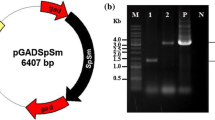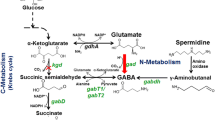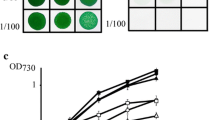Abstract
Glutaminase is widely distributed among microorganisms and mammals with important functions. Little is known regarding the biochemical properties and functions of the deamidating enzyme glutaminase in cyanobacteria. In this study a putative glutaminase encoded by gene slr2079 in Synechocystis sp. PCC 6803 was investigated. The slr2079 was expressed as histidine-tagged fusion protein in Escherichia coli. The purified protein possessed glutaminase activity, validating the functional assignment of the genomic annotation. The apparent Km value of the recombinant protein for glutamine was 26.6 ± 0.9 mmol/L, which was comparable to that for some of other microbial glutaminases. Analysis of the purified protein revealed a two-fold increase in catalytic activity in the presence of 1 mol/L Na+. Moreover, the Km value was decreased to 12.2 ± 1.9 mmol/L in the presence of Na+. These data demonstrate that the recombinant protein Slr2079 is a glutaminase which is regulated by Na+ through increasing its affinity for substrate glutamine. The slr2079 gene was successfully disrupted in Synechocystis by targeted mutagenesis and the Δslr2079 mutant strain was analyzed. No differences in cell growth and oxygen evolution rate were observed between Δslr2079 and the wild type under standard growth conditions, demonstrating slr2079 is not essential in Synechocystis. Under high salt stress condition, however, Δslr2079 cells grew 1.25-fold faster than wild-type cells. Moreover, the photosynthetic oxygen evolution rate of Δslr2079 cells was higher than that of the wild-type. To further characterize this phenotype, a number of salt stress-related genes were analyzed by semi-quantitative RT-PCR. Expression of gdhB and prc was enhanced and expression of desD and guaA was repressed in Δslr2079 compared to the wild type. In addition, expression of two key enzymes of ammonium assimilation in cyanobacteria, glutamine synthetase (GS) and glutamate synthase (GOGAT) was examined by semi-quantitative RT-PCR. Expression of GOGAT was enhanced in Δslr2079 compared to the wild type while GS expression was unchanged. The results indicate that slr2079 functions in the salt stress response by regulating the expression of salt stress related genes and might not play a major role in glutamine breakdown in Synechocystis.
Similar content being viewed by others
References
Nandakumar R, Yoshimune K, Wakayama M, et al. Microbial glutaminase: biochemistry, molecular approaches and applications in the food industry. J Mol Catal B Enzymes, 2003, 23: 87–100, 10.1016/S1381-1177(03)00075-4, 1:CAS:528:DC%2BD3sXms12itrw%3D
Krebs H A. Metabolism of amino-acids: The synthesis of glutamine from glutamate and ammonia, and the enzymatic hydrolysis of glutamine in animal tissues. Biochem J, 1935, 29: 1951–1969, 16745865, 1:CAS:528:DyaA2MXmtFSrug%3D%3D
Watford M, Smith E M, Erbelding E J. The regulation of phosphate-activated glutaminase activity and glutamine metabolism in the streptozotocin-diabetic rat. Biochem J, 1984, 224: 207–214, 6508757, 1:CAS:528:DyaL2MXktFSh
Smith E M, Watford M. Molecular cloning of a cDNA for rat hepatic glutaminase: Sequence similarity to kidney-type glutaminase. J Biol Chem, 1990, 265: 10631–10636, 2191954, 1:CAS:528:DyaK3cXkvFeqt78%3D
Curthoys N P, Watford M. Regulation of glutaminase activity and glutamine metabolism. Annu Rev Nutr, 1995, 15: 133–159, 8527215, 10.1146/annurev.nu.15.070195.001025, 1:CAS:528:DyaK2MXntVCjsro%3D
Masola B, Zvinavashe E. Phosphate-dependent glutaminase in enterocyte mitochondria and its regulation by ammonium and other ions. Amino Acids, 2003, 24: 427–434, 12768506, 10.1007/s00726-002-0312-x, 1:CAS:528:DC%2BD3sXntlaltbg%3D
Márquez J, López de la Oliva A R, Matés M J, et al. Glutaminase: A multifaceted protein not only involved in generating glutamate. Neurochem Int, 2006, 48: 465–471, 16516349
Prusiner S. Glutaminases of Escherichia coli: Properties, regulation and evolution. In: Prusiner S, Stadtman E R, eds. The Enzymes of Glutamine Metabolism. New York: Academic Press, 1973. 293–316
Prusiner S, Davis J N, Stadtman E R. Regulation of glutaminase B in Escherichia coli. I. Purification, properties, and cold lability? J Biol Chem, 1976, 251: 3447–3456, 6454, 1:CAS:528:DyaE28XksVaktrw%3D
Duran S, Sanchez-Linares L, Huerta-Saquero A, et al. Identification of two glutaminases in Rhizobium etli. Biochem Genet, 1996, 34: 453–465, 9126674, 10.1007/BF00570126, 1:CAS:528:DyaK2sXisl2qu7s%3D
Masuo N, Ito K, Yoshimune K, et al. Molecular cloning, overexpression, and purification of Micrococcus luteus K-3-type glutaminase from Aspergillus oryzae RIB40. Protein Expres Purif, 2004, 38: 272–278, 10.1016/j.pep.2004.09.003, 1:CAS:528:DC%2BD2cXhtVSnt7jE
Wakayama M, Yamagata T, Kamemura A, et al. Characterization of salt-tolerant glutaminase from Stenotrophomonas maltophilia NYW-81 and its application in Japanese soy sauce fermentation. J Ind Microbiol Biotechnol, 2005, 32: 383–390, 16012776, 10.1007/s10295-005-0257-7, 1:CAS:528:DC%2BD2MXht1WntLjL
Kaneko T, Sato S, Kotani H, et al. Sequence analysis of the genome of the unicellular cyanobacterium Synechocystis sp. strain PCC6803. II. Sequence determination of the entire genome and assignment of potential protein-coding regions. DNA Res, 1996, 3: 109–136, 8905231, 10.1093/dnares/3.3.109, 1:CAS:528:DyaK28Xmtl2qsLc%3D
Muro-Pastor M I, Reyes J C, Florencio F J. Ammonium assimilation in cyanobacteria. Photosynth Res, 2005, 83: 135–150, 16143848, 10.1007/s11120-004-2082-7, 1:CAS:528:DC%2BD2MXhslGntrg%3D
Chen C H, Baalen C V, Tabita F R. DL-7-azatryptophan and citrulline metabolism in the cyanobacterium Anabaena sp. strain 1F. J Bacteriol, 1987, 169: 1114–1119, 2880834, 1:CAS:528:DyaL2sXhsFaktLw%3D
Allen M M. Simple conditions for growth of unicellular blue-green algae on plates. J Phycol, 1968, 4: 1–4, 10.1111/j.1529-8817.1968.tb04667.x, 1:CAS:528:DyaF1MXotVKl
Thompson J D, Higgins D G, Gibson T J. Clustal W: improving the sensitivity of progressive multiple sequence alignment through sequence weighting, position-specific gap penalties and weight matrix choice. Nucleic Acids Res, 1994, 22(Suppl 22): 4673–4680, 7984417, 10.1093/nar/22.22.4673, 1:CAS:528:DyaK2MXitlSgu74%3D
Williams J G K. Construction of specific mutations in photosystem II photosynthetic reaction center by genetic engineering methods in Synechocystis 6803. Methods Enzymol, 1988, 167: 766–778, 10.1016/0076-6879(88)67088-1, 1:CAS:528:DyaL1MXhvVKqs7g%3D
Kenny J, Bao Y, Hamm B, et al. Bacterial expression, purification, and characterization of rat kidney-type mitochondrial glutaminase. Protein Expr Purif, 2003, 31: 140–148, 12963351, 10.1016/S1046-5928(03)00161-X, 1:CAS:528:DC%2BD3sXntVGkt7s%3D
Cann M J, Hammer A, Zhou J, et al. A defined subset of adenylyl cyclases is regulated by bicarbonate ion. J Biol Chem, 2003, 278: 35033–35038, 12829712, 10.1074/jbc.M303025200, 1:CAS:528:DC%2BD3sXntVWqt74%3D
Curthoys N P, Weiss R F. Regulation of renal ammoniagenesis. Subcellular localization of rat kidney glutaminase isoenzymes. J Biol Chem, 1974, 249: 3261–3266, 4364420, 1:CAS:528:DyaE2cXkt1entr8%3D
Oka A, Sugisake H, Takanami M. Nucleotide sequence of the kanamycin resistance transposon Tn 903. J Mol Biol, 1981, 147: 217–226, 6270337, 10.1016/0022-2836(81)90438-1, 1:CAS:528:DyaL3MXkslGltro%3D
Wang H L, Postier B L, Burnap R L. Polymerase chain reaction-based mutageneses identify key transporters belonging to multigene families involved in Na+ and pH homeostasis of Synechocystis sp. PCC 6803. Mol Microbiol, 2002, 44: 1493–1506, 12067339, 10.1046/j.1365-2958.2002.02983.x, 1:CAS:528:DC%2BD38Xlt1amtrw%3D
Porra R J, Thompson W A, Kriedemann P E. Determination of accurate extinction coefficients and simultaneous equations for assaying chlorophylls a and b extracted with four different solvents: Verification of the concentration of chlorophyll standards by atomic absorption spectroscopy. Biochim Biophys Acta, 1989, 975: 384–394, 10.1016/S0005-2728(89)80347-0, 1:CAS:528:DyaL1MXkvFehtL4%3D
Vioque A. Analysis of the gene encoding the RNA subunit of ribonuclease P from cyanobacteria. Nucleic Acids Res, 1992, 20: 6331–6337, 1282240, 10.1093/nar/20.23.6331, 1:CAS:528:DyaK3sXit1Ojsr4%3D
Yano S, Kamemura A, Yoshimune K, et al. Analysis of essential amino acid residues for catalytic activity of glutaminase from Micrococcus luteus K-3. J Biosci Bioeng, 2006, 102: 362–364, 17116585, 10.1263/jbb.102.362, 1:CAS:528:DC%2BD28Xhtlemsr3P
Klein M, Kaltwasser H, Thomas J. Isolation of a novel, phosphate-activated glutaminase from Bacillus pasteurii. FEMS Microbiol Lett, 2002, 206: 63–67, 11786258, 10.1111/j.1574-6968.2002.tb10987.x, 1:CAS:528:DC%2BD38XitFahsg%3D%3D
Allakhverdiev S I, Sakamoto A, Nishiyama Y, et al. Ionic and osmotic effects of NaCl-induced inactivation of photosystems I and II in Synechococcus sp. Plant Physiol, 2000, 123: 1047–1056, 10889254, 10.1104/pp.123.3.1047, 1:CAS:528:DC%2BD3cXlt1Slt74%3D
Kanesaki Y, Suzuki I, Allakhverdiev S I, et al. Salt stress and hyperosmotic stress regulate the expression of different sets of genes in Synechocystis sp. PCC 6803. Biochem Biophys Res Commun, 2002, 290: 339–348, 11779175, 10.1006/bbrc.2001.6201, 1:CAS:528:DC%2BD38XhsFCnuw%3D%3D
Muro-Pastor M I, Florencio F J. Regulation of ammonium assimilation in cyanobacteria. Plant Physiol Biochem, 2003, 41: 595–603, 10.1016/S0981-9428(03)00066-4, 1:CAS:528:DC%2BD3sXlsVals78%3D
Moriguchi M, Sakai K, Tateyama R, et al. Isolation and characterization of salt-tolerant glutaminase from marine Micrococcus luteus K-3. J Ferment Bioeng, 1994, 77: 621–625, 10.1016/0922-338X(94)90143-0, 1:CAS:528:DyaK2cXlslemt7s%3D
Marin K, Suzuki I, Yamaguchi K, et al. Identification of histidine kinases that act as sensors in the perception of salt stress in Synechocystis sp. PCC 6803. Proc Natl Acad Sci USA, 2003, 100: 9061–9066, 12853569, 10.1073/pnas.1532302100, 1:CAS:528:DC%2BD3sXlvVyhsr4%3D
Huang F, Fulda S, Hagemann M, et al. Proteomic screening of salt-stress-induced changes in plasma membranes of Synechocystis sp. strain PCC 6803. Proteomics, 2006, 6: 910–920, 16400685, 10.1002/pmic.200500114, 1:CAS:528:DC%2BD28XhvFWku7o%3D
Fulda S, Mikkat S, Huang F, et al. Proteome analysis of salt stress response in the cyanobacterium Synechocystis sp. strain PCC 6803. Proteomics, 2006, 6: 2733–2745, 16572470, 10.1002/pmic.200500538, 1:CAS:528:DC%2BD28XltF2it7s%3D
Author information
Authors and Affiliations
Corresponding author
Additional information
Supported by the National Natural Sciences Foundation of China (Grant No. 30500108) and Hundred Talents Program of Chinese Academy of Sciences.
Rights and permissions
About this article
Cite this article
Zhou, J., Zhou, J., Yang, H. et al. Characterization of a sodium-regulated glutaminase from cyanobacterium Synechocystis sp. PCC 6803. SCI CHINA SER C 51, 1066–1075 (2008). https://doi.org/10.1007/s11427-008-0137-2
Received:
Accepted:
Published:
Issue Date:
DOI: https://doi.org/10.1007/s11427-008-0137-2




